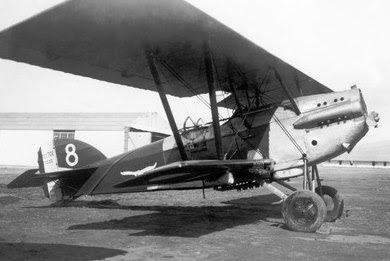The aircraft was further developed into the 25M, a standard parasol-wing monoplane, which never entered production.
In May 1925, the prototype was tested at the Service Technique d'Aeronautique Institute and was found a promising construction both for its manoeuvrability, speed and durability. Following the tests, the prototype entered serial production. To promote the new aircraft abroad, in a post-World War I market filled with hundreds of cheap demobilized aircraft, the Potez 25 was entered into a large number of races.
-------------------
Military Operators
- Afghan Air Force
- Belgian Air Force
- Brazilian Air Force
- Chinese Nationalist Air Force
- Independent State of Croatia
- Royal Yugoslav Air Force.
Zrakoplovstvo Nezavisne Države Hrvatske captured 42 from the Royal Yugoslav Air
- Ethiopian Air Force acquired 3 aircraft.
- Estonian Air Force operated Potez 25 Jupiter up to 1940.
- Finnish Air Force purchased one Potez 25 A2 to try out its flying qualities in 1927. The aircraft was flown more than 700 hours, but no deal was made. It was used
until 1936.
- French Air Force
- Free French Air Force
- Hellenic Air Force
- Guatemalan Air Force
- Imperial Japanese Army Air Service
- Imperial Japanese Navy Air Service - Purchased as Potez CXP.
- Paraguayan Air Force operated a total of 14 aircraft, six Potez 25 A.2
and eight Potez 25 TOE during the Chaco War against Bolivia.
- Polish Air Force operated 16 aircraft bought in France
and another 300 aircraft manufactured in Poland.
- Portuguese Air Force
- Royal Romanian Air Force
- Spanish Republican Air Force
- Swiss Air Force
- Soviet Air Force - Two aircraft used for tests and trials.
- Turkish Air Force
- United States Army Air Corps
- Uruguayan Air Force
- Kingdom of Yugoslavia
- Yugoslav Royal Air Force operated 200 aircraft manufactured in Yugoslavia.
Crew: 2
Length: 9.2 m
Wingspan: 14.14 m
Height: 3.59 m
Wing area: 51.4 m²
Empty weight: 1,490 kg
Loaded weight: 2,558 kg
Useful load: 1,068 kg
Powerplant: 1 × Lorraine-Dietrich 12Eb water-cooled W12 inline, 357 kW (478 hp)
Maximum speed: 214 km/h
Range: 600 km
Service ceiling: 5,500 m
Rate of climb: 3.5 m/s
Wing loading: 49.8 kg/m²
Power/mass: 0.14 kW/kg
Armament: 1 × 7.7 mm (.303 in) mg in front, 2 × 7.7 mm mg, on rear cockpit
+ 200 kg bombs
-------------------------------------
Such achievements added to aircraft's popularity and made it one of the most successful French aircraft of the epoch. It was bought by a number of air forces, including those of France, Switzerland, Belgium, Brazil, Croatia, Estonia, Ethiopia, Finland, Greece, Spain, Japan, Yugoslavia, Paraguay, Poland, Portugal, Romania, Turkey and the USSR. After the USSR acquired two aircraft for testing, they decided against further purchases, finding it comparable to the native Polikarpov R-5. Altogether, approximately 2,500 aircraft were built in France.
Already in 1925, Poland bought a licence for Potez 25 and started to manufacture them in Podlaska Wytwórnia Samolotów (PWS, 150 built) and Plage i Laśkiewicz aircraft works (150 built). In 1928 the first Polish-built Potez 25 were tested by the Technical Aviation Development Institute in Warsaw and the design was slightly modified to better fit the needs of the Polish air forces. Among the notable differences were the introduction of leading edge slots. The production in Poland ceased in 1932. Altogether, 300 aircraft were built in a number of versions for long- and short-range reconnaissance and daylight tactical bombing. As the original Lorraine-Dietrich 12Eb engine was unavailable in Poland, it was replaced in 47 aircraft with a more powerful PZL Bristol Jupiter VIIF radial engine, starting from 1936.
In Romania, Potez 25 was produced by IAR. Several other countries manufactured Potez 25s under licence.







Ei kommentteja:
Lähetä kommentti
Kaikenlaiset kommentit ovat tervetulleita.